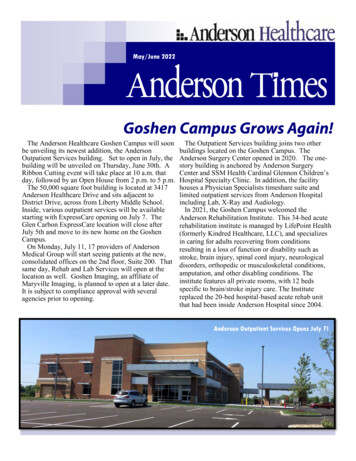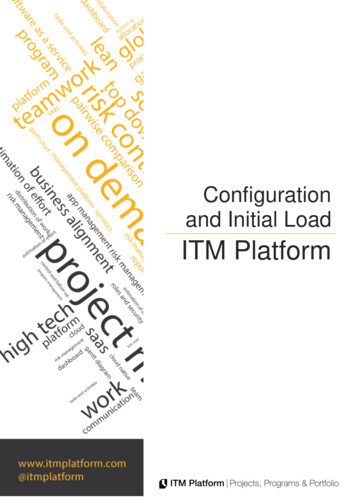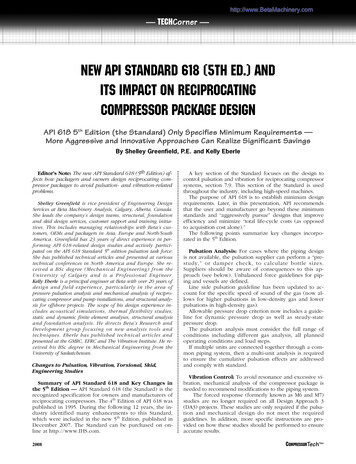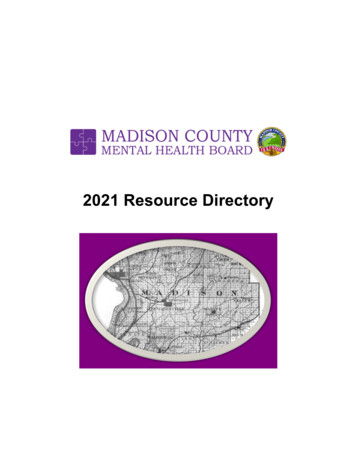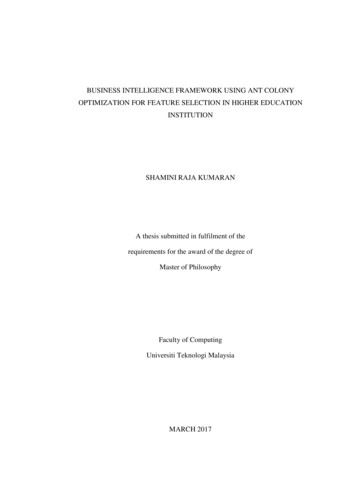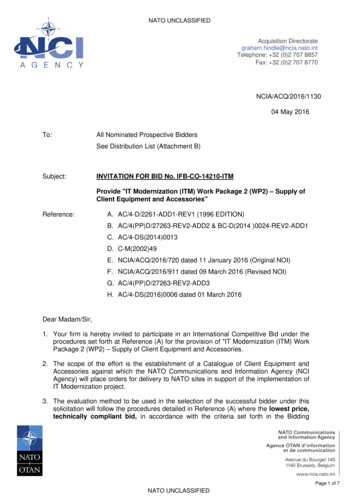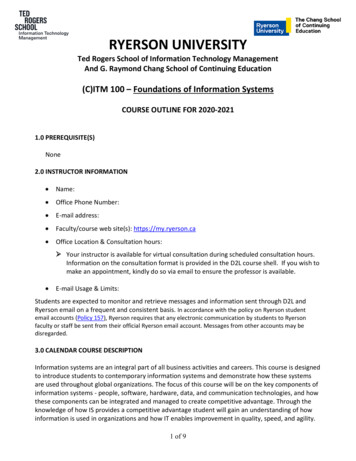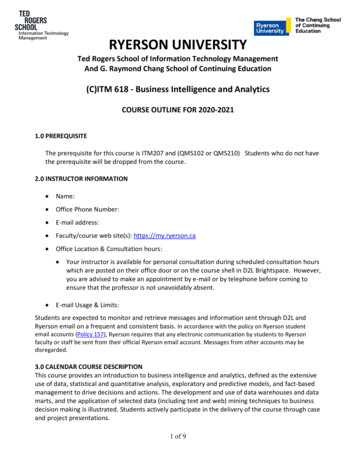
Transcription
RYERSON UNIVERSITYTed Rogers School of Information Technology ManagementAnd G. Raymond Chang School of Continuing Education(C)ITM 618 - Business Intelligence and AnalyticsCOURSE OUTLINE FOR 2020-20211.0 PREREQUISITEThe prerequisite for this course is ITM207 and (QMS102 or QMS210) Students who do not havethe prerequisite will be dropped from the course.2.0 INSTRUCTOR INFORMATION Name: Office Phone Number: E-mail address: Faculty/course web site(s): https://my.ryerson.ca Office Location & Consultation hours: Your instructor is available for personal consultation during scheduled consultation hourswhich are posted on their office door or on the course shell in D2L Brightspace. However,you are advised to make an appointment by e-mail or by telephone before coming toensure that the professor is not unavoidably absent.E-mail Usage & Limits:Students are expected to monitor and retrieve messages and information sent through D2L andRyerson email on a frequent and consistent basis. In accordance with the policy on Ryerson studentemail accounts (Policy 157), Ryerson requires that any electronic communication by students to Ryersonfaculty or staff be sent from their official Ryerson email account. Messages from other accounts may bedisregarded.3.0 CALENDAR COURSE DESCRIPTIONThis course provides an introduction to business intelligence and analytics, defined as the extensiveuse of data, statistical and quantitative analysis, exploratory and predictive models, and fact-basedmanagement to drive decisions and actions. The development and use of data warehouses and datamarts, and the application of selected data (including text and web) mining techniques to businessdecision making is illustrated. Students actively participate in the delivery of the course through caseand project presentations.1 of 9
4.0 COURSE OBJECTIVES AND LEARNING OUTCOMESLearning outcomes describe what students are expected to have learned or achieved; as a result,they usually describe what students will be capable of doing, or what evidence will be provided tosubstantiate learning.Fact-based management has always been a critical management practice, only gaining moreattention by recent trends such as the overabundance and variety of data available to managers,progress in technologies that can process such data, and the intensity of competition that drives thequest for ever increasing organizational efficiency. The organizations that will sustain theircompetitive edge in this environment will be those that not only invest in technologies to capture,store, process, and report data, but add human creativity to these processes. Thus this course aimsto arm students with major skills required for business analytics as well as an understanding ofcritical issues and trends in this area.COURSE OBJECTIVESTo gain an understanding of how managers to use business analytics to formulate and solve businessproblems and support decision making To become familiar with the processes needed to develop, report, and analyze business data To implement analytical models in the software tools, interpret the results of businessanalytics and their implications to business administrations and make data driven decisions tooptimize the business process and address issues in business administrations To identify key components of a Business Analytics process, implement analytical models inthe software tools, interpret the results of business analytics and their implications to businessadministrations and make data driven decisions to optimize the business process and addressissues in business administrations.5.0 TEXTS & OTHER READING MATERIALSTitle: Data Science for Business: What You Need to Know about Data Mining and Data-AnalyticThinkingAuthor: Foster Provost, Tom FawcettPublisher: O’ReillyISBN: 978-1449361327Title: Business Intelligence, Analytics, and Data Science: A Managerial Perspective, 4th EditionAuthor: Ramesh Sharda, Dursun Delen, Efraim TurbanPublisher: PearsonISBN: 978-0134633282Suggested/Recommended TextbookTitle: Modeling Techniques in Predictive Analytics with Python and R.Author: Thomas W. MillerPublisher: Pearson2 of 9
ISBN-13: 978-0133892062Other readings/cases will be distributed in class or electronically.6.0 TEACHING METHODSIn Fall 2020 this course will be taught will be taught remotely in virtual classrooms. Instruction willtake place at scheduled hours, following the approach outlined in D2L Brightspace. You will not berequired to attend the Ryerson University campus to complete this course.The pedagogical approach for this course is based on the principles of experiential learning. Thecourse will incorporate the following teaching/learning methods: Lectures, readings, case studyanalysis, labs exercises, group project and discussions are the primary teaching methods in thiscourse. Students are expected to have studied the assigned readings and completed any online orwritten pre-class assignments prior to attending the lectures. The lectures will review and expandthe textual material and provide students with the professor’s commentary, examples, andillustration. The case studies will be used to link theoretical foundations to practice in a businesscontext. The group project will enable students to develop their “soft skills”. Each student isexpected to contribute to assigned tasks/assignments and the group project. An additional 9 hourswill be required each week for independent reading, research, and practice using the software.7.0 EVALUATION, ASSESSMENT AND FEEDBACKThe grade for this course is composed of the mark received for each of the following components:Evaluation ComponentAssignmentsCourse ProjectMidterm ExaminationFinal ExaminationTotalPercentage of the Final Grade20%25%20%35%100%NOTE: Students must achieve a course grade of at least 50% to pass this course. At least 20% of student’s grade based on individual work will be returned tostudents prior to the last date to drop a course in good academic standing .Citation Format for Essays and Term PapersAll essay assignments, term paper and other written works must adhere with APA citation format.Technical errors (spelling, punctuation, proofing, grammar, format, and citations) and/orinappropriate levels of language or composition will result in marks being deducted. You areencouraged to obtain assistance from the Writing Centre (www.ryerson.ca/writingcentre) for helpwith your written communications as needed.You can find APA guidelines and academic referencing from the following online resources:3 of 9
Student Learning Support Online Resources Writing Support Resources APA Basic Style GuideRyerson Library Citations and Style Guides APA Style8.0 PLAGIARISM DETECTIONTurnitin.com is a plagiarism prevention and detection service to which Ryerson subscribes. It is a toolto assist instructors in determining the similarity between students’ work and the work of otherstudents who have submitted papers to the site (at any university), internet sources, and a widerange of books, journals and other publications. While it does not contain all possible sources, itgives instructors some assurance that students’ work is their own. No decisions are made by theservice; it generates an “originality report,” which instructors must evaluate to judge if something isplagiarized.Students agree by taking this course that their written work will be subject to submission for textualsimilarity review to Turnitin.com. Instructors can opt to have student’s papers included in theTurnitin.com database or not. Use of the Turnitin.com service is subject to the terms-of-useagreement posted on the Turnitin.com website. Students who do not want their work submitted tothis plagiarism detection service must, by the end of the second week of class, consult with theirinstructor to make alternate arrangements.Even when an instructor has not indicated that a plagiarism detection service will be used, or when astudent has opted out of the plagiarism detection service, if the instructor has reason to suspect thatan individual piece of work has been plagiarized, the instructor is permitted to submit that work in anon-identifying way to any plagiarism detection service.9.0 TOPICS – SEQUENCE & SCHEDULESessionTopic1Introduction to BusinessIntelligence, Analyticsand Decision Support2Business Intelligence andData WarehousingLearning OutcomesReading(s)Get familiarizedyourself withimportant BI/BA/DSSterminology,concepts, and issues- Understand thedifferencebetweenoperationaldatabases anddata warehousesB1 – CH01B2 – CH014 of 9B2 – CH03Activities & DueDates
-3Data Cleaning andVisualization4Introduction to DataMining5Predictive AnalyticsDefine theconcept of a“data mart” andvarious datawarehousearchitectures- Apply OLAPoperationsGet familiarizedfuture datawarehousing trends- Describe thenature of data- Explain themethods used tomake real-worlddata analyticsready- Identify differenttypes ofvisualizationtechniquesUnderstand thecapabilities andlimitations ofdashboard- Get familiarizedwith the widerange ofapplications ofdata mining- Understand thestandardizedbusinessanalytics processDescribe Supervisedand unsuperviseddata mining- Apply(supervised)classificationtechniques- Understand withcorrelationanalysis5 of 9B2 – CH02B1 – CH02B2 – CH04B1 – CH03B2 – CH04Assignment 1
-6Statistical Modeling:Regression Analysis7Midterm Examination8Similarity, Neighbors,and Clusters9Model PerformanceAnalytics and ionExplain parameterestimation- Get familiarizedB1 – CH04with the conceptof statisticalmodeling forbusiness- Demonstratelinear/logisticregression modelfor businessIdentify “optimal”model parametersbased on techniques- chniques- Explain similarityof objectsdescribed by dataApply similarity forprediction- Understandvisualization ofmodelperformanceunder variouskinds ofuncertainty- Explain furtherconsideration ofwhat is desired6 of 9B1 – CH06B2 – CH04B1 – CH05B1 – CH08Assignment 1gradesIntro. GroupProjectAssignment 2
10Representing and MiningText11Introduction to Big Data12Emerging BusinessAnalytics Trends andFuture Impactsfrom dataanalytics results- Explainunderfitting andoverfitting, crossvalidation andregularization.Get familiarized withprofit curves;cumulative responsecurves; lift curves;ROC curves- Explainrepresentation oftext for dataanalytics- Understand theconcept ofNatural LanguageProcessingApply text mining toa collection ofdocuments- Understand thesimilarities anddifferencesbetweentraditional and“big” datacollectionsGet familiarized withbig data technologiessuch as Hadoop,Apache Spark andNoSQL- Describe theconcept of BI/DAin a cloudcomputingenvironment- UnderstandBI/BA impacts onorganizationsExplain advanced BATasks and Techniques7 of 9B1 – CH10B2 – CH05Midterm gradesB2 – CH07Assignment 2gradesB1 – CH12B2 – CH08Group Project
10.0 VARIATIONS WITHIN A COURSEAll sections of a course (Day and CE sections) will follow the same course outline and will use thesame course delivery methods, methods of evaluation, and grading schemes. Any deviations will beposted on D2L Brightspace once approved by the course coordinator.11.0 OTHER COURSE, DEPARTMENTAL, AND UNIVERSITY POLICIESFor more information regarding course management and departmental policies, please consult theCourse Outline Appendix which is posted on the Ted Rogers School of Information TechnologyManagement website.NOTE: Students must adhere to all relevant university policies found in their online course shell inD2L and /or on the following URL: senate-course-outline-policies.The appendix covers the following topics:Attendance & Class ParticipationEmail AccountRequest for Academic ConsiderationExaminations & TestsLate AssignmentsStandard of Written WorkAcademic Grading PolicyAcademic IntegrityStudent RightsImportant Resources Available at Ryerson Academic Accommodation Support: Ryerson University acknowledges that students havediverse learning styles and a variety of academic needs. If you have a diagnosed disabilitythat impacts your academic experience, connect with Academic Accommodation Support(AAS). Visit the AAS website or contact aasadmin@ryerson.ca for more information. Note: Allcommunication with AAS is voluntary and confidential, and will not appear on yourtranscript.8 of 9
The Library provides research workshops and individual assistance. If the University is open,there is a Research Help desk on the second floor of the library, or go to Workshops. Student Learning Support offers group-based and individual help with writing, math, studyskills, and transition support, as well as resources and checklists to support students as onlinelearners. You can submit an Academic Consideration Request when an extenuating circumstance hasoccurred that has significantly impacted your ability to fulfill an academic requirement. Ryerson COVID-19 Information and Updates for Students summarizes the variety ofresources available to students during the pandemic. Familiarize yourself with the tools you will need to use for remote learning. The Continuity ofLearning Guide for students includes guides to completing quizzes or exams in D2L orRespondus, using D2L Brightspace, joining online meetings or lectures, and collaborating withthe Google Suite.9 of 9
This course provides an introduction to business intelligence and analytics, defined as the extensive use of data, statistical and quantitative analysis, exploratory and predictive models, and fact-based . Visit the AAS website or contact aasadmin@ryerson.ca for more information. Note: All communication with AAS is voluntary and confidential .
